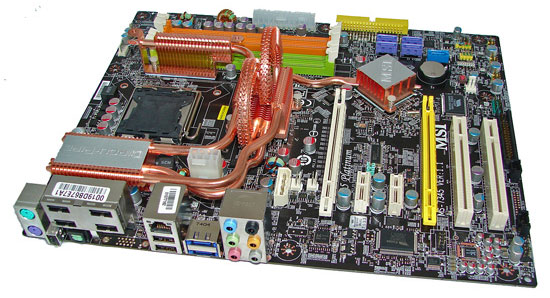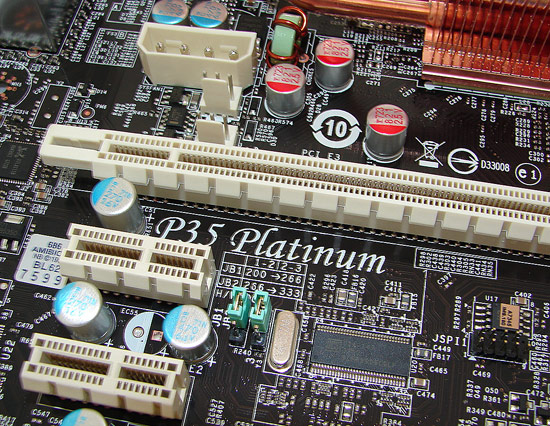Intel P35: Intel's Mainstream Chipset Grows Up
by Gary Key & Wesley Fink on May 21, 2007 3:45 PM EST- Posted in
- CPUs
MSI P35 Platinum Basic Features
| MSI P35 Platinum | |
| Market Segment: | Enthusiast - $199.99 |
| CPU Interface: | Socket T (Socket 775) |
| CPU Support: | LGA775-based Pentium 4, Celeron D, Pentium D, Pentium EE, Core 2 Duo, Core 2 Extreme |
| Chipset: | Intel P35 MCH and Intel ICH9R |
| Bus Speeds: | Auto, 200 ~ 600 in 1MHz increments |
| Memory Speed: DDR2 | Auto,1:1, 1:1.2, 1:2, 1:1.25, 1:1.66, 1:1.5 |
| PCIe Speeds: | Auto, 100MHz~200MHz in 1MHz Increments |
| Core Voltage: | Auto, 1.100V ~ 2.300V |
| SB Voltage: | 1.05V, 1.15V |
| SB I/O Voltage: | 1.50V ~1.80V in .05V increments |
| CPU Clock Multiplier: | Auto, 6x-50x in 1X increments if CPU is unlocked, downwards unlocked, Core 2 Duo |
| DRAM Voltage: DDR2 | Auto, 1.80V ~ 3.30V |
| DRAM Timing Control: | Auto, 9 DRAM Timing Options |
| NB Voltage: | Auto, 1.250V ~ 1.650V in .025V increments |
| FSB Voltage: | Auto, 1.175V ~ 1.500V in .025V increments |
| Memory Slots: | Four 240-pin DDR2 DIMM Slots Dual-Channel Configuration Regular Unbuffered Memory to 8GB Total |
| Expansion Slots: | 2 - PCIe X16 (1x16, 1x4 electrical for CrossFire or Multi-GPU) 2 - PCIe x1 2 - PCI Slot 2.2 |
| Onboard SATA/RAID: | 4 SATA 3Gbps Ports - ICH9R (RAID 0,1, 10, 5) 2 eSATA 3Gbps Port - ICH9R 1 SATA 3Gbps Port - Marvell 88SE6111 |
| Onboard IDE: | 1 ATA133/100/66 Port (2 drives) - Marvell 88SE6111 |
| Onboard USB 2.0/IEEE-1394: | 12 USB 2.0 Ports - 6 I/O Panel - 6 via Headers 2 Firewire 400 Ports by VIA VT6308 - 1 I/O Panel, 1 via Header |
| Onboard LAN: | Realtek RTL8111B PCIe Gigabit Ethernet controller |
| Onboard Audio: | Realtek ALC888 - 8-channel HD audio codec |
| Power Connectors: | ATX 24-pin, 8-pin EATX 12V, 4-pin Molex connector |
| I/O Panel: | 1 x PS/2 Keyboard 1 x PS/2 Mouse 2 x eSATA 1 x S/PDIF Optical - Out 1 x IEEE 1394a 1 x Audio Panel 1 x RJ45 6x USB 2.0/1.1 |
| BIOS Revision: | v.P01 |
| Board Revision: | v1.10 |
The MSI BIOS offers a decent set of options available for tweaking the board with specific emphasis placed on the available memory settings. Voltage options are rather limited but the range of voltage options available is impressive. Only our high end modules from OCZ, Corsair, and Patriot were able to operate at tight timings with absolute stability. However, until we received the latest BIOS release this weekend the board would not boot with 4GB of memory. MSI has made great strides over the past two weeks in getting this board to perform well with BIOS updates, and we fully expect the performance levels to match or come close to the other currently available P35 boards in the near future.
MSI P35 Platinum Board Layout and Features
 |
| Click to enlarge |
MSI did a really nice job in the layout of this board as all features on the board except for the floppy drive connector are easily reached. This board features a four-phase power regulation solution and conductive polymer aluminum capacitors that provided very good stability during testing. In a fight to outdo the other manufacturers in the heatpipe wars, MSI provided a roller coaster design that looks as interesting as it works. During our overclocking tests we found the heatpipe system results were on par with the other offerings provided additional airflow was available around the CPU area when using a cooler such as the Tuniq 120.

The board installed easily into our Cooler Master CM Stacker 830 case and cable management was very good for power, optical, and hard drives. Due to the tight clearances around the heatpipe, MSI includes an extender for the 8-pin ATX connector. We did not have any issues installing larger heat sinks on this board. The first DIMM slot is right against the rear heatpipe and the memory cannot be installed without removing the graphics card. MSI also includes a manual jumper system on the board that lets the user set a FSB speed of 200, 266, or 333 manually. The BIOS will automatically adjust settings to compensate for the change.










58 Comments
View All Comments
Comdrpopnfresh - Tuesday, May 22, 2007 - link
The power could be attributed to the DDR3. With it not being so mature there may be a lot of signaling going on that isn't necessary. Also- with all the new technologies, these boards simply have more going on on them. With more transistors on a cpu its is expected they will use more power- more connections and circuits on a board would mean the same. Everything is running faster too. The power consumption doesn't make sense given the lack of matching real-world performance enhancements, but as the article makes good sense in pointing out, Bios are a big contributing factor here.TA152H - Tuesday, May 22, 2007 - link
Except they ran the power tests with DDR2 on P35 based machines as well, and they were higher than P965 with the same memory. So, obviously, that isn't the cause in this instance.Gary Key - Tuesday, May 22, 2007 - link
After speaking with the board manufacturers and Intel, our original thoughts (briefings/white paper review) were confirmed that the additional circuitry required on the P35 DDR3 boards and in the MCH result in the increased power consumption on the DDR3 platform compared to the DDR2 platform. This holds true for the P35 DDR2 boards when compared to the DDR2 P965, the additional DDR3 circuity/instruction set is still active even though it is not being used. This is why you will see the DDR2/DDR3 combo boards shortly. However, the BIOS engineers believe that can work a little magic with the SpeedStep and C1E wait states to reduce power consumption, however we are talking just a few watts at best. More on this subject in the roundup, at least we hope we will have more... ;)TA152H - Tuesday, May 22, 2007 - link
Gary,Thanks, it's useful to know. Are they going to shackle the x38 with DDR2 support too?
Just confirms my earlier opinion, they should have gotten rid of DDR2 support. Intel is an interesting company, they can come out with a great product like the Core 2, and then have some monkey decide to include DDR2 and DDR3 on the P35. You never know if they'll have a clue, or not. I guess it's a good thing they make turkeys like this and the P7, otherwise we wouldn't have AMD. Although AMD might be the cause of this.
The monkey that decided to do this probably thought, "Oh, look what we can do that AMD can't". It seems to me they did that with the P7, a technological marvel way beyond AMD's capability to design, thank goodness, and the groundbreaking Itanium. Except neither one worked great. AMD's pragmatism has paid off nicely, and even though they can't realistically support DDR2 and DDR3 on the same motherboard, I don't think they really care. Of course, I'm just guessing, when a company does something this stupid, it's always difficult to understand why they did it. It would have been so simple to just have DDR3 support for the P35, and let the P965 handle the DDR2 crowd. It's perfectly adequate.
Thanks again for the information. It's disappointing, but with Intel you get used to it. They can't do everything right after all, and still be Intel.
strikeback03 - Wednesday, May 23, 2007 - link
There might be a more practical reason, such as lack of production capability for DDR3 or HP and Dell threatening to use VIA chipsets instead of P35 in order to keep using DDR2 and keep their prices competitive. I doubt consumers would like their prices increasing by a few hundred dollars for no noticeable performance improvement. And if they only keep the computer 3 or 4 years they will probably spend less on energy than on that DDR3.Who knows about X38, I'd guess DDR2 support won't disappear until the chipset revision for Nehalem.
TA152H - Wednesday, May 23, 2007 - link
Well, I agree if P35 were the only choice from Intel, this would be the case, but again, would you buy VIA if you could get a P965? I wouldn't. If the P965 were a lousy, and seriously obsolete chipset, yes, sure, you'd have to come out with something that replaced it. But they could have easily validated it for FSB of 1333, and at the point the only thing really new in the P35 would be the DDR3 support. So, why would you need it?I was going to get the P35 rather than the x38 because I figure x38 will be even more of a power hog considering the, to me, useless features it has. I don't plan on getting two high-end video cards, and I don't think I will run anything that requires twice the performance of the current PCI-E, but if they drop the DDR2 support, it might the one to go after. If you ever look at an Athlon 64 CPU, you can see the memory controller is simply enormous, so dropping it on the x38 could be significant. With it being high end, they may decide DDR2 isn't a high end technology so they drop it. I hope so.
JarredWalton - Monday, May 21, 2007 - link
Could be the Vista factor? I dunno what else to think about the power numbers.XcomCheetah - Wednesday, May 23, 2007 - link
Could you do a little testing on it... why so high power numbers..Secondly if i remember correctly the power number difference between 680i and P965 chipsets was greater than 20W.. but in your current tests the difference is pretty small.? So any guess what has caused this positive change.?
Reference
http://www.anandtech.com/cpuchipsets/showdoc.aspx?...">http://www.anandtech.com/cpuchipsets/showdoc.aspx?...
http://www.xbitlabs.com/articles/chipsets/display/...">http://www.xbitlabs.com/articles/chipsets/display/...
current power numbers on Anandtech
http://www.anandtech.com/cpuchipsets/showdoc.aspx?...">http://www.anandtech.com/cpuchipsets/showdoc.aspx?...